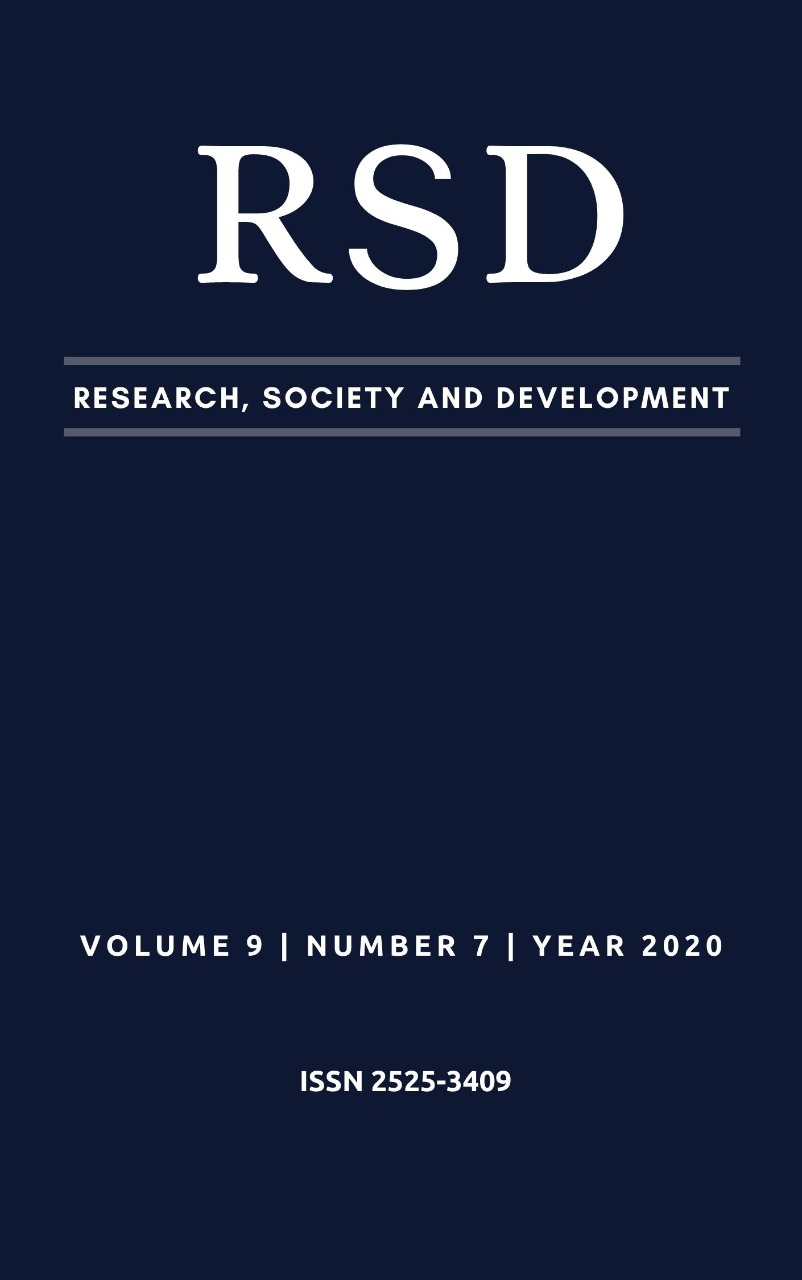Incontinencia urinaria continua secundaria a ectopia ureteral intramural bilateral en un canino femenino Shiba inu - Informe de un caso
DOI:
https://doi.org/10.33448/rsd-v9i7.4350Palabras clave:
Nefrología; Enfermedad congénita; Citoscopia; Ablación ureteral.Resumen
El propósito de este informe es describir el diagnóstico y el tratamiento quirúrgico de la ectopia ureteral bilateral, en un perro Shiba Inu, con resolución del signo clínico de incontinencia urinaria persistente. La ectopia ureteral es una anomalía congénita, que resulta de una falla en la embriogénesis renal. Entre los tipos de uréter ectópico, el intramural se clasifica en el que el uréter se ubica en la superficie dorsal o dorso-lateral de la vejiga, generalmente pasando a través de la submucosa para abrirse en la uretra o en la vagina y, los extramuros, los que van más allá de la vejiga. Fue posible verificar la presencia de alteración ureteral mediante un examen tomográfico, donde se observó la inserción ectópica de los uréteres en el contraste. Por lo tanto, con la confirmación del diagnóstico, el paciente fue derivado al procedimiento quirúrgico realizado con la ayuda de uretroscopia y se realizó la técnica de ablación ureteral con láser. Hubo una mejora en la queja clínica de incontinencia después del procedimiento. Por lo tanto, en presencia de incontinencia urinaria persistente o intermitente en animales jóvenes, la ectopia ureteral congénita debe incluirse en el diagnóstico diferencial.
Citas
Bjorling, J.D. & Christie, G. (1998). Ureteres. In: Slatter, D. Manual de Cirurgia de Pequenos Animais. 2.ed. São Paulo: Manole. 1714-1720.
Balogh, O., Degrandi, F., Hassig, M. & Reichler, I.M. (2015) Validation of screening examinations of the ureteral orifices in dogs: comparison of ultrasonography with dissection. Research Veterinary Science, 1:(101):199-205.
Berent, A.C., Mayhew, P.D. & Porat-Mosenco, Y. (2008). Use of cystoscopic- guided laser ablation for treatment of intramural ureteral ectopia in male dogs: four cases (2006- 2007). Journal of America Veterinary Medical Association,1(232):1026–1034.
Berent, A.C., Weisse, C., Mayhew, P.D., Todd, K.; Wright, M. & Bagley, D. (2012). Evaluation of cystoscopic-guided laser ablation of intramural ectopic ureters in female dogs. Journal of America Veterinary Medical Association, 240(6):716-725.
Canola, J.C., Lacreta Jr, A.C.C., Sanches, R.C. & Maniscalco, C.L. (2006). Incontinência urinária em cadela associada com ureter e ureterocele ectópicos. Revista Nosso Clinico, 9(1):36-42.
Costa Neto, J.M., Silva, A.E., Martins Filho, E.F., Ribeiro, L.G.R., Gama, R.O.G., Penha, E.M., Toríbio, J.M.M.L. & Gomes Jr., D.C. (2011). Ectopia ureteral em cães: relato de dois casos. Arquivos de Ciências Veterinárias e Zoologia, 14(1):151-156.
Espada, Y., Novellas, R. & Ruiz de Gopegui, R. (2006). Renal ultrasound in dogs and cats. Veterinary Research Communications, 30(1):133-137.
Fernández, S.A., Redondo, M.S., Verdugo, B.C., Cabrera, J.S. & Rueda, R.L. (2007). Diagnóstico de ectopia ureteral mediante ureterocistoscopia transuretral y vaginoscopia en el perro. Revista complutense de ciencias veterinarias, 1(2):409-415.
Giles, D.J., Nixon, G.W. & Middleton Jr, A.W. (1982). Vaginal ectopic ureter: A continuing diagnostic challenge. Western Journal Medicine,136:436-439.
Grauer, G.F. (2010). Distúrbios do trato urinário. In: Nelson, R.N. & Couto, C.G. Medicina Interna de Pequenos Animais. 3ed. Rio de Janeiro: Elsevier, 1:609-697.
Ho, L.K., Troy, G.C. & Waldron, D.R. (2011). Clinical outcomes of surgically managed ectopic ureters in 33 dogs. Journal of the American Animal Hospital Association, 47:196-202.
Holt, P.E., Gibbs, C. & Pearson, H. (1982). Canine ectopic ureter—a review of twenty-nine cases. Journal Small Animals Practicers, 23:195–208.
Holt, P.E. & Moore, A.H. (1995). Canine ureteral ectopia: an analysis of 175 cases and comparison of surgical treatments. Veterinary Research,136:345–349.
Kienle, G.S. & Kiene, H. (2011). Como escrever um relato de caso. Arte Médica Ampliada, 31(2):1-4.
Mayhew, P.D., Lee, K.C.L., Gregory, S.P. & Brockman, D.J. (2006). Comparison of two surgical techniques for management of intramural ureteral ectopia in dogs: 36 cases (1994–2004). Journal of the American Veterinary Medical Association, 229(3):389–393.
McCarthy, T.C. (2006). Transurethral cystoscopy and diode laser incision to correct an ectopic ureter. Veterinary Medicine, 101:558–559.
McLoughlin, M.A. & Chew, D.J. (2000). Diagnosis and surgical management of ectopic ureters. Clinical Techniques in Small Animal Practice, 15(1):17-24.
McLoughlin, M.A. (2008). Doenças do sistema urogenital. In: Birchard, S.J. & Sherdin, R.G. Manual saunders de clínica de pequenos animais. São Paulo: Roca, p.906-907.
Meric, S.M. (1997). Poliúria e polidipsia. In: Ettinger, S.J. & Feldman, E.C. Tratado de medicina interna veterinária. 4.ed. São Paulo: Manole, p.220-226.
Novellas, R., Stone, J., Pratschke, K. & Hammond, G. (2014). Duplicated ectopic ureter in a nine-year-old Labrador. Journal Small Animal Practicers, 54(1):386-389..
Osborne, C.A., Johnston, G.R. & Kruger, J.M. (1995). Ectopic ureters and ureteroceles. In: Osborne, C.A. & Finco, D.R. Canine and feline nephrology and urology. Williams & Wilkins, Philadelphia, p.608-620.
Pereira, AS, Shitsuka, DM, Parreira, FJ & Shitsuka, R. (2018). Metodologia da pesquisa científica. [e-book]. Santa Maria. Ed. UAB/NTE/UFSM. p. Disponível em: https://repositorio.ufsm.br/bitstream/handle/1/15824/Lic_Computacao_Metodologia-Pesquisa-Cientifica.pdf?sequence=1.
Reichler, I.M., Specker, C.E., Hubler, M. Boss, A., Haessig, M. & Arnold, S. (2012). Ectopic ureters in dogs: Clinical features, surgical techniques and outcome. Veterinary surgery, 41(4):515-522.
Stone, E.A., Mason, L.K. (1990). Surgery of ectopic ureters: types method of correction, and postoperative results. Journal of the American Veterinary Medical Association, 26(1):81–88.
Descargas
Publicado
Cómo citar
Número
Sección
Licencia
Los autores que publican en esta revista concuerdan con los siguientes términos:
1) Los autores mantienen los derechos de autor y conceden a la revista el derecho de primera publicación, con el trabajo simultáneamente licenciado bajo la Licencia Creative Commons Attribution que permite el compartir el trabajo con reconocimiento de la autoría y publicación inicial en esta revista.
2) Los autores tienen autorización para asumir contratos adicionales por separado, para distribución no exclusiva de la versión del trabajo publicada en esta revista (por ejemplo, publicar en repositorio institucional o como capítulo de libro), con reconocimiento de autoría y publicación inicial en esta revista.
3) Los autores tienen permiso y son estimulados a publicar y distribuir su trabajo en línea (por ejemplo, en repositorios institucionales o en su página personal) a cualquier punto antes o durante el proceso editorial, ya que esto puede generar cambios productivos, así como aumentar el impacto y la cita del trabajo publicado.

